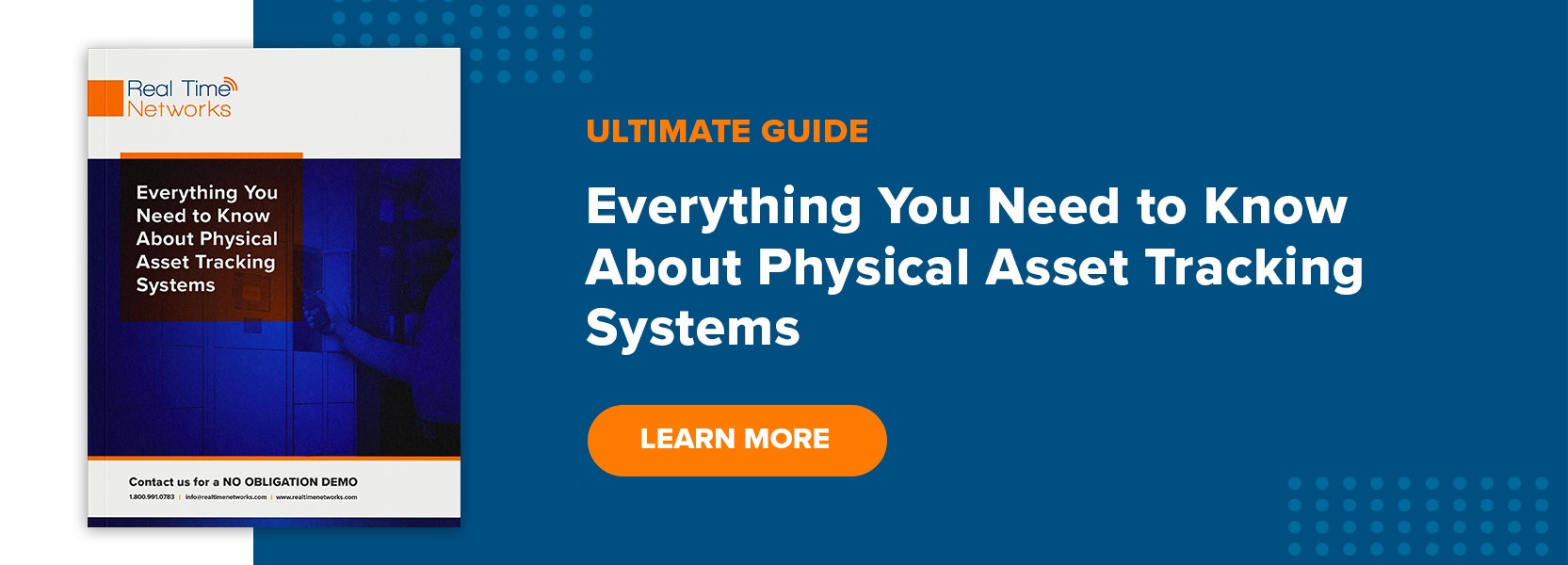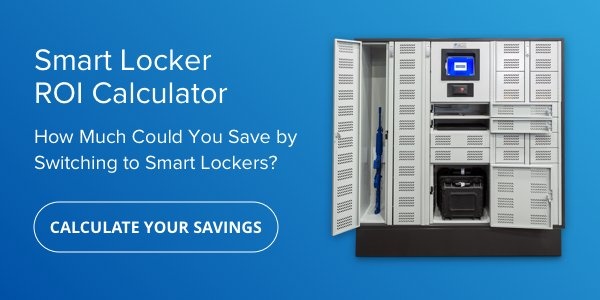By Jay Palter | April 9, 2021
Securing and managing a large equipment inventory doesn’t need to be a headache. Instead of using manual tracking processes and standard security lockers, many businesses find that deploying the latest generation of smart lockers is a worthwhile investment.
Smart security lockers are secure storage cabinets that have a built-in sensor network and computer management system. They securely store equipment and automatically manage its distribution. They alert supervisors to late and irregular transactions, and they can automatically compile detailed usage logs.
6 Reasons to Invest in Smart Security Lockers
Here are six of the top reasons why investing in smart security lockers will pay off in the long run.
1. Security lockers reduce costs.
Smart security lockers automate many of the time-consuming tasks that are a part of equipment management. This automation reduces labor and allows you to redirect staff to more revenue-generating activities.
Computer-assisted access control ensures that only the staff authorized to use specific equipment can sign it out. Managers can use the detailed usage logs they automatically compile for internal reporting or regulatory compliance. All equipment is securely stored.
2. They improve operations.
Smart lockers not only reduce the labor needed to distribute equipment, but they can also do it much faster and more reliably than their human counterparts. For example, wireless RFID scanners in a smart locker can instantly verify the return of multiple tagged items inside a locked hard case. Kit checks take seconds instead of minutes.
Because they’re networked, smart lockers can integrate right into your maintenance and repair processes. The locker access terminal can present checklists to users when they sign out or sign in a device to verify everything is in working order. If the user reports a problem, the smart locker system can prompt them to deposit the device in a specially designated maintenance locker while it alerts the technical support team.
Supervisors can also do everything from one-off access requests to emergency asset releases from any authorized PC or mobile device. Connections are secure, so off-site supervisors can handle urgent issues from their phone or tablet without needing to go into the office.
3. They provide consistent process controls.
Many organizations undergoing digital transformations want to use networked mobile devices for process control. Smart lockers ensure every staff member using a mobile device has it when they need it.
Charging ports built into smart lockers ensure those devices are always ready. Electronics-friendly smart lockers should also be cooled or ventilated to extend the lifecycles of expensive assets
4. Smart lockers reduce equipment losses.
Supervisors can specify how long users can sign out different types of equipment. The smart locker system can send them a text or email alert when a device is overdue, which allows them to respond as soon as the equipment is missing, increasing the chance of recovery.
Smart lockers can also come equipped with content surveillance systems. These systems verify that a user has signed out or returned the correct piece of equipment by scanning a wireless RFID tag during a transaction or reading a device ID over a wired connection. Content surveillance keeps staff accountable for equipment in their possession.
5. They automate standards and regulatory compliance.
Smart locker management systems provide customizable reports on transactions and equipment health. If your business needs to use regulated equipment or controlled substances, you can easily provide detailed usage reports for compliance.
Many quality control standards also require asset and inventory controls, such as ISO 9001. Smart locker automation simplifies standards compliance and takes much of the administrative burden off staff.
6. They support better change management.
High-quality data collected by smart locker systems provide better, faster insights. Trends in use and staff performance will reveal themselves sooner, which allows you to optimize processes sooner. You can generate efficiency gains that will snowball over time into a competitive advantage against rivals who are stuck using manual processes.
Applications for Many Business Sectors
Many different business sectors can leverage security lockers to reduce costs and provide a favorable return on their security investment.
Track and manage business equipment.
You can use smart security lockers to track, manage, and locate all of your essential business equipment. Make sure two-way radios are always charged and available when they’re needed. Identify who last signed out a missing handheld scanner and launch an immediate recovery effort.
Automate evidence storage.
Smart lockers can automate the most time-consuming aspects of evidence management. They can automatically collect chain-of-custody forms. Using deposit checklists, they can ensure users log all necessary case info when they deposit evidence in the system.
Traditionally, these tasks have been performed manually by evidence managers. Smart evidence lockers perform these tasks automatically around the clock so materials are available to detectives or technicians working any shift. Refrigerated locker compartments can also safely store biological evidence.
Track EMS assets.
Smart lockers improve how emergency services teams manage their medkits. Lockers securely store kits when they’re not in use with reliable access controls.
Content surveillance scanners automatically verify that every narcotic vial is present and accounted for when kits are signed out or returned. Automated logging ensures all regulated materials are tracked for compliance.
Manage police gear.
Law enforcement agencies can use smart security lockers to manage their shared pools of weapons and equipment efficiently. Smart lockers reduce the time needed to locate and distribute critical resources during both routine operations and emergency response efforts.
Handle tablet and laptop distribution.
Smart lockers can quickly and efficiently manage electronic device distribution for any busy organization. They cut equipment losses nearly to zero. Maintenance checklists and alerts simplify device handoffs between users and break/fix technicians.
Package delivery.
Online and retail businesses are increasingly using smart lockers to offer automated, secure package pickups. When their product is ready for pickup, users receive a one-time use access code. They enter that code into the locker system’s access terminal at any time of day to receive their package, no waiting necessary.
Tips to Set up a New Smart Security Locker System
After understanding how they might use smart security lockers in their organization, many people are left wondering how they can set up their own customized system. Smart lockers are capable of carrying out quite complex tasks, but their setup is reasonably straightforward.
Identify everything you want to track.
Start by taking a step back and think about your organization’s asset management as a process. What equipment do you want to track? What workplace activities is that equipment used in?
Inventory all of that equipment and the locations in and out of your workplace where they are needed. Identify the locations where you want to securely and efficiently distribute that equipment.
Determine who needs to access it.
Once you know what you need to store and distribute, determine who will need to access each different device in your organization. Also, determine who needs supervisory access to the locker management system.
For example, which supervisors should get alerts when equipment returns are overdue? Which managers can generate and customize reports?
Determine how smart lockers will integrate into your overall operations.
Integration is one of the most powerful capabilities of smart lockers. Their automation can connect and streamline many broader operations.
But the more significant their impact on your operations, the more training and policy setting will be necessary for smart locker solutions to be effective. For example, you will need to set clear expectations for what a supervisor must do when they receive an alert that a user didn’t return a device on time.
Or suppose you’re going to use smart lockers to improve employee accountability. In that case, you will want a clear policy outlining consequences and performance management steps should an employee lose a tracked asset or underreport consumable items in inventory.
Decide what technology you need.
Once you’ve clearly outlined all of your inventories and processes, you can decide which smart locker technology will be the best fit for your needs. Look for a system with an easy-to-use management portal that can get administrators the information they need fast.
Evaluate each potential solution based not only on the capabilities the product offers but also on its provider’s service and support. Smart security lockers are powerful, living technologies that will grow and adapt along with your organization. You need a partnership with your system provider to ensure the system is effective over its entire lifecycle.
Ways Smart Security Locker Automation Streamlines Your Business
Security lockers don’t force you to reinvent operations. They take your current operations and make them even better.
Smart security lockers simplify complex tasks and make work happen faster and in a safer manner. They take care of the tedious work that comes with equipment management and allow your personnel to focus on tasks best handled by human beings.
Want to find out if a smart security locker system might be cost-effective in your organization? Try out our Smart Locker ROI Calculator.
Subscribe to our blog

Jay Palter
Vice President of Marketing & Partnerships






